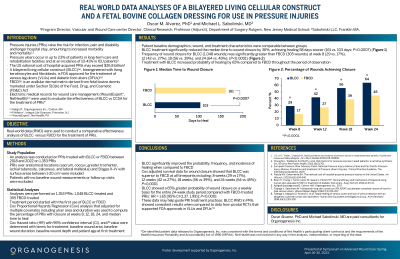Clinical Research
(CR-058) Comparative Effectiveness of a Bilayered Living Cellular Construct and a Fetal Bovine Collagen Dressing for use in Pressure Injuries
Friday, April 28, 2023
7:15 PM - 8:30 PM East Coast USA Time

Oscar Alvarez, PhD
Introduction: Using real-world data (RWD) we conducted a comparative effectiveness analysis of bilayered living cellular construct (BLCC)(a) versus a fetal bovine collagen dressing (FBCD)(b) for the treatment of Pressure Injuries (PRIs).
Methods: Electronic medical records (WoundExpert®, Net Health, PA)(c) collected between 2018 and 2022 on 1,353 PRIs were analyzed. Ulcers 1-20 cm2 were included. Patients with no baseline wound measurements or follow-up visits were excluded. Evaluations were performed on 1,048 BLCC- and 305 FBCD- treated PRIs. A Cox analysis that adjusted for variables including ulcer area and duration was used to compute frequency and time to healing. The Hazard Ratio (HR) was computed to determine the probability of achieving healing throughout the study.
Results: Patient populations were well matched for patient demographics, wound characteristics, and treatment characteristics. The median time to healing was 161 days for FBCD and 103 days for BLCC. This difference between groups demonstrated a 36% reduction in time to healing with the use of BLCC; (p< 0.0007). The frequency of healing for BLCC was significantly greater compared to FBCD at week 8 (29 vs 17%), 12 (42 vs 27%), 18 (56 vs 39%), and 24 (64 vs 45%); p< 0.0001. The HR = 1.65 [95% CI (1.37, 1.99)]; p< 0.0001. Treating PRIs with BLCC resulted in a 65% greater probability of healing compared to FBCD at each timepoint over the entire study.
Discussion: RWD analyses demonstrated that BLCC significantly improved healing compared to FBCD for the treatment of PRIs. These data may help guide PRI treatment practices. BLCC RWD in PRIs showed consistent results when compared to data from pivotal RCTs that supported FDA approvals in VLUs and DFUs [1,2].
Methods: Electronic medical records (WoundExpert®, Net Health, PA)(c) collected between 2018 and 2022 on 1,353 PRIs were analyzed. Ulcers 1-20 cm2 were included. Patients with no baseline wound measurements or follow-up visits were excluded. Evaluations were performed on 1,048 BLCC- and 305 FBCD- treated PRIs. A Cox analysis that adjusted for variables including ulcer area and duration was used to compute frequency and time to healing. The Hazard Ratio (HR) was computed to determine the probability of achieving healing throughout the study.
Results: Patient populations were well matched for patient demographics, wound characteristics, and treatment characteristics. The median time to healing was 161 days for FBCD and 103 days for BLCC. This difference between groups demonstrated a 36% reduction in time to healing with the use of BLCC; (p< 0.0007). The frequency of healing for BLCC was significantly greater compared to FBCD at week 8 (29 vs 17%), 12 (42 vs 27%), 18 (56 vs 39%), and 24 (64 vs 45%); p< 0.0001. The HR = 1.65 [95% CI (1.37, 1.99)]; p< 0.0001. Treating PRIs with BLCC resulted in a 65% greater probability of healing compared to FBCD at each timepoint over the entire study.
Discussion: RWD analyses demonstrated that BLCC significantly improved healing compared to FBCD for the treatment of PRIs. These data may help guide PRI treatment practices. BLCC RWD in PRIs showed consistent results when compared to data from pivotal RCTs that supported FDA approvals in VLUs and DFUs [1,2].

.png)